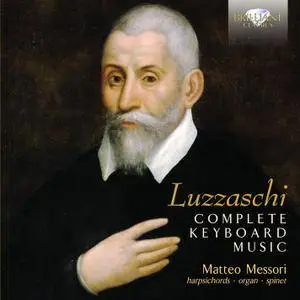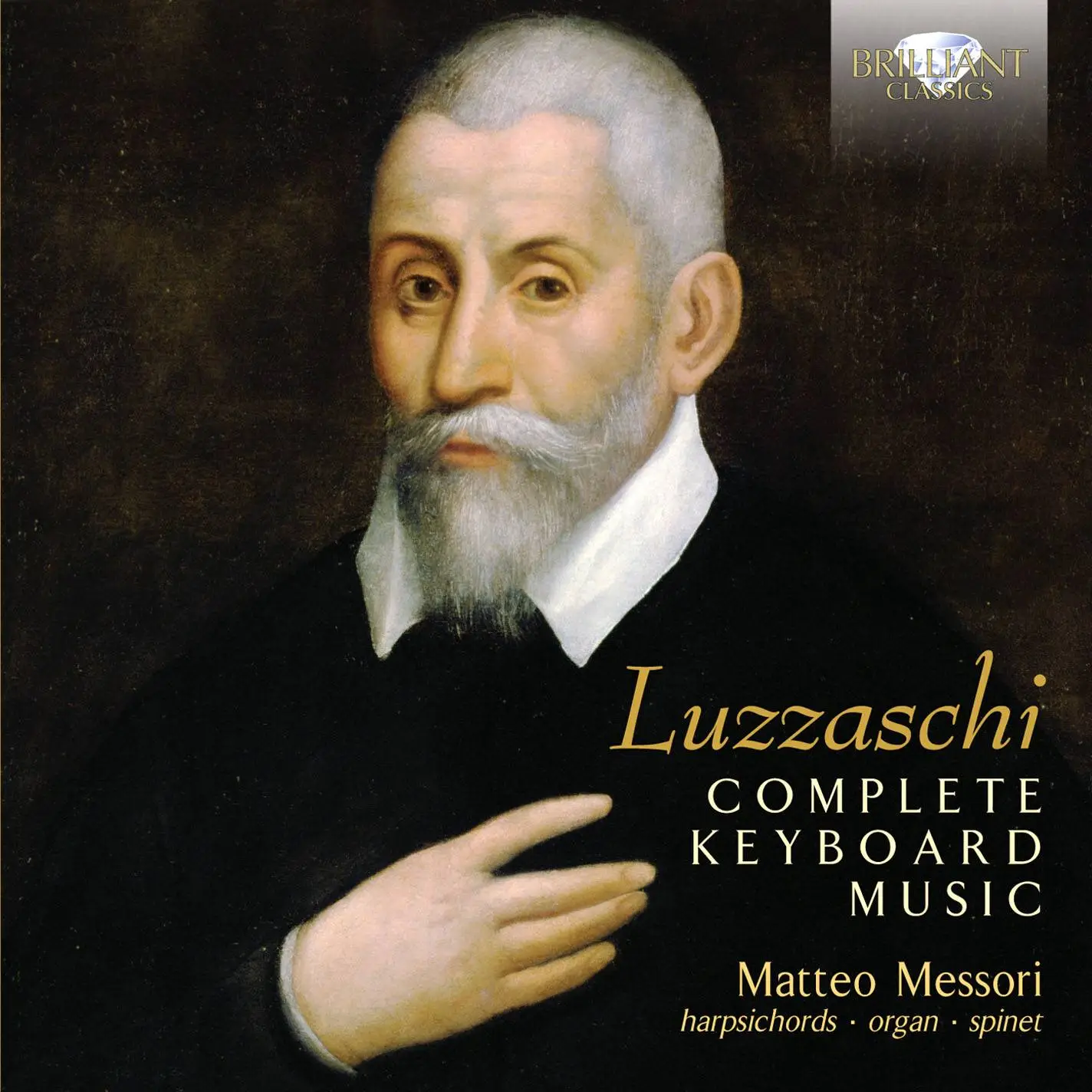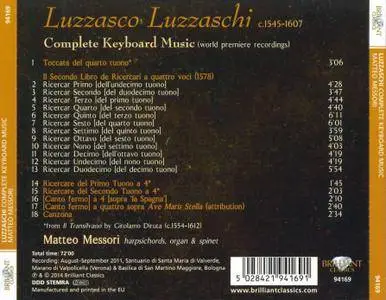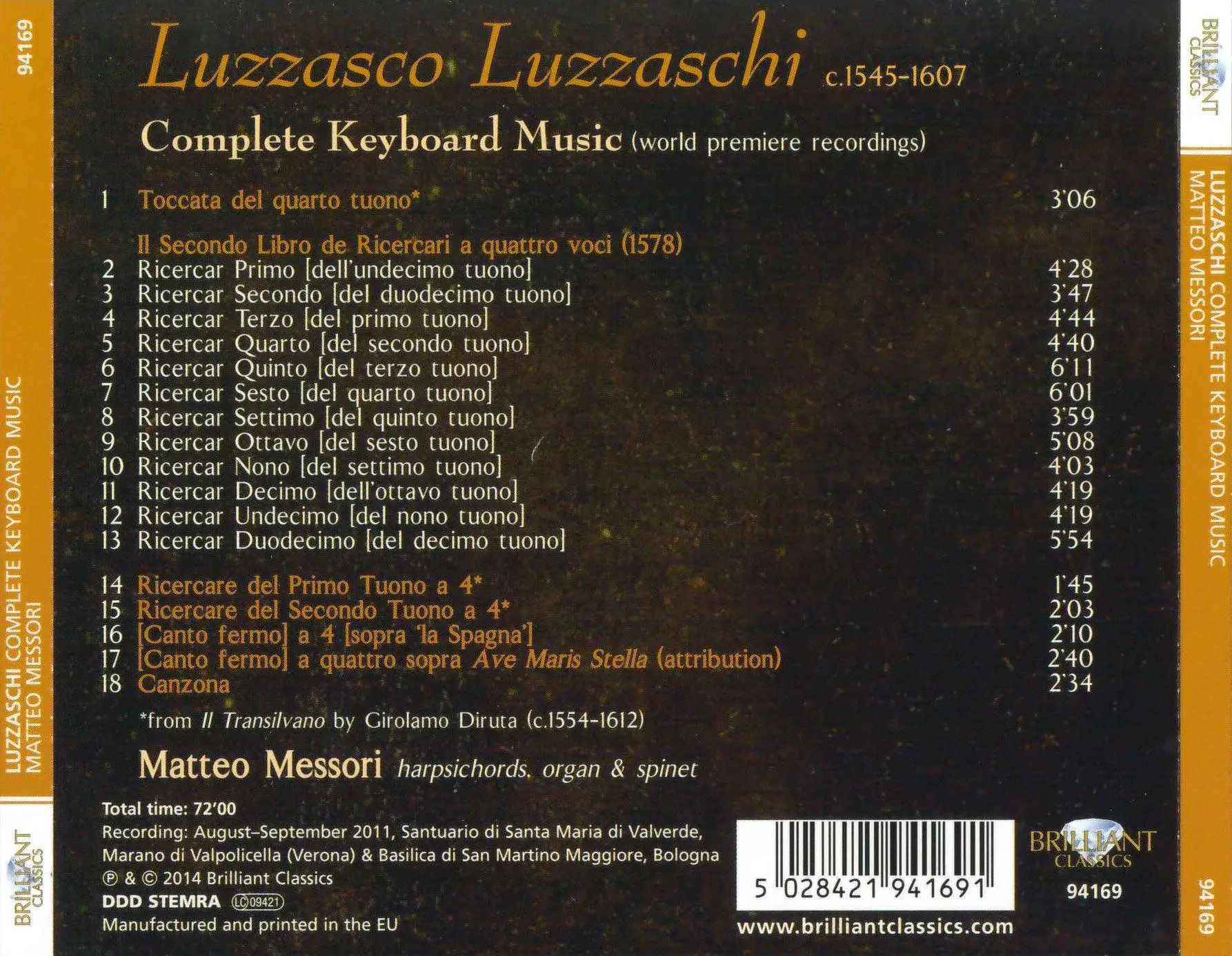Matteo Messori - Luzzasco Luzzaschi: Complete Keyboard Music (2014)
EAC | FLAC | Image (Cue&Log) ~ 424 Mb | Mp3 (CBR320) ~ 170 Mb | Scans included
Genre: Classical | Label: Brilliant Classics | # 94169 | Time: 01:12:00
EAC | FLAC | Image (Cue&Log) ~ 424 Mb | Mp3 (CBR320) ~ 170 Mb | Scans included
Genre: Classical | Label: Brilliant Classics | # 94169 | Time: 01:12:00
The Ferrara‐born Luzzasco Luzzaschi might not exactly be a household name, but his contribution to the development of the madrigal places him within that elite category of composers who helped shape the course of music history. The favourite musician of Duke Alfonso II, the last of the legitimate d’Este (the most intellectual and cultivated dynasty of Renaissance Italy) it was Luzzaschi who, in his role as the finest keyboard player of the period, cultivated the open score approach to performance. This was essentially a sort of motet of madrigal without words that focused on highly refined counterpoint and on the complexity of fugues i.e. four‐voice writing, without recourse to embellishment or any added prettiness.
Only the second of the composer’s three books of ricercari, as detailed in this recording, has survived – a regrettable fact, given that the 1578 manuscript is unrivalled in its complexity among keyboard music of the second half of the 16th century. The book also comprises the only known free‐form composition by Luzzaschi, the melancholic Toccata del quarto tuono; also included on the recording are two counterpoints on the plainchants “La Spagna” and Ave Maris stella, as well as the simple, unpretentious Canzona – Maestro Messori’s keyboard arrangement of an ensemble piece published in the Raveri collection of Canzoni per sonare con ogni sorte di stromenti (1608) by various composers. Indeed, Messori’s interest in and understanding of this period of music history is confirmed by his critical open score edition used for the recording (shortly to be published by ‘Ut Orpheus’ at the time of writing), as well as his assured performances. Using different Italian harpsichords to convey a sense of “chamber music”, in addition to the organ and spinet, he conjures up the refinement and splendour of the Ferrarese court with ease and grace, presenting a strong case for why this Renaissance composer – and former teacher of Frescobaldi, who further cultivated keyboard open‐score notation – deserves to be better‐known.
RECORDING OF THE MONTH
Luzzasco Luzzaschi is a key figure in music history. He lived and worked at the time that the prima prattica which was dominated by polyphony made way for the seconda prattica with its emphasis on expression of emotions through a close connection between text and music.
Luzzaschi was admired for his madrigals most of which are written in the 'old style', but some of them were arranged for one to three voices and basso continuo. The reason for this was the presence of three ladies at the court of Ferrara where Luzzaschi worked, who were highly-skilled singers. They were known as the Concerto delle donne (or delle Dame) whose singing caused great astonishment and excitement. It is telling that Girolamo Frescobaldi, the most prominent exponent of the seconda prattica in keyboard music, considered Luzzaschi as a model. He was one of his pupils.
Today Luzzaschi is almost exclusively known as a composer of madrigals but he was educated as a keyboard player and considered one of the best organists of his time. The fact that the present disc is the first ever recording of his keyboard works attests to the neglect of Luzzaschi's output in this genre. It is known that he published four collections of keyboard music, but only the second book of ricercari has been preserved. That is highly regrettable considering the quality of what has come down to us.
The ricercar was one of the main forms of keyboard music. It existed in two forms, the imitative and the non-imitative. Luzzaschi's ricercares belong to the former category: they comprise a sequence of fugues and each section is built on some contrasting themes. There are twelve ricercares, each of them in a different mode. Every mode is connected to a specific kind of affetto. The complex counterpoint of these ricercares explains why Carlo Gesualdo also greatly admired Luzzaschi as he considered him a champion of the 'old style'. The collection was published in an open score, meaning that every voice is assigned a separate stave. In his liner-notes Matteo Messori points to the fact that Angelo Gardano, the Venetian publisher of Luzzaschi's keyboard collection, had printed before a collection of madrigals by Cipriano de Rore, also in an open keyboard score, without the texts. He suggests that Luzzaschi, who was Rore's pupil, may have been involved in the publication of this edition.
It also bears witness to the close connection between vocal and keyboard music. These Rore madrigals without texts were undoubtedly intended for keyboard performance. Composers such as Andrea Gabrieli wrote ricercares on themes from vocal music, for instance madrigals. However, even without such themes ricercares often have a vocal character, and the present disc shows that there is a close connection between Luzzaschi's madrigals and his keyboard works.
In the booklet Messori discusses some aspects of performance practice. One issue is especially interesting: he quotes an author from 1640 who stated that Luzzaschi "soberly played the most refined subtleties of his counterpoint in an intellectual manner, without any prettiness". This remark especially regards the use of ornaments, in particular to fill in the intervals. Apparently the clarity of the contrapuntal discourse was more important to Luzzaschi than the addition of virtuosic trills and other embellishments.
This explains why there are few of them in Messori's performance. Trills are mainly played at cadences where they are probably written out. He plays these pieces on three different harpsichords, a spinet (only in the last piece) and an organ. It is notable that the three harpsichords are all copies of historical Italian instruments but produce a quite different sound. That makes this recording all the more interesting. The organ is a splendid historical instrument which is highly appropriate for this repertoire.
The collection of 1578 is the heart of this disc, but the programme is extended by some pieces which Girolamo Diruta included in his treatise on playing the organ, Il Transilvano. The two pieces on La Spagna - a then popular bassadanza tune - and the plainsong Vesper hymn Ave maris stella respectively are from the Vatican library where they are attributed to Luzzaschi. The Canzona which closes the programme is Messori's transcription of an ensemble piece included in a collection of music by various composers from 1608.
The reader will understand that this disc is a highly important production. Luzzaschi was a significant composer in music history, one of the most brilliant keyboard players of his time, admired and influential. That is reason enough to investigate this disc. Moreover, the music is highly compelling, Matteo Messori delivers brilliant and captivating performances on splendid instruments. He is also the writer of the very informative liner-notes in which this repertoire and its composer are put into historical perspective.
There are plenty of reasons to label this disc Recording of the Month.Review by Johan van Veen, MusicWeb-International.com
Luzzasco Luzzaschi lived from about 1545 to 1607. He was one of many composers, artists, poets and even philosophers to benefit from the patronage of the Este family in Ferrara in north central Italy. Although best known for his madrigals, Luzzaschi was evidently so accomplished also as a keyboard player that he attracted the admiration (and envy) of his contemporaries. Established as organist at Ferrara, Luzzaschi's influence was significant – not least on his great pupil, Frescobaldi. Luzzaschi's style was typical of the practice at Ferrara of eschewing overdone ornamentation while at the same time developing complex and profound counterpoint.
This is just what we hear on this excellent CD from Brilliant with Italian specialist Matteo Messori: an emphasis of substance over surface. He plays modern harpsichords built after anonymous Venetian and Neapolitan originals; the organ built by Giovanni Cipri in 1556 at Ferrara and later moved to Bologna where it was restored and enlarged in the 18th, 19th and late 20th centuries; and a modern spinet after Guarracino. Even if Luzzaschi's music were not varied and creative at every turn, this variety of palette in the keyboard instruments chosen aids our understanding and appreciation of the composer's use of color and timbre.
Of the dozen and a half pieces on the 72-minute CD, the majority (14) are in the ricercar form, which can imply several musical directions taken by composers. In this case Luzzaschi's works are mostly contrapuntal, serious and tend towards long notes, rather than having multiple runs and elaborations. Although he composed and published three books of ricercari, only the second survives; one ricercar for each tone is presented, but – unusually – in relation to the last notes of each mode, not the first. Zarlino's treatise of 1558 clearly influenced Luzzaschi.
Messori's playing is gentle and sensitive when it needs to hold back, as in the Eleventh Ricercar [tr.12]; more dominant (though never strident) when he feels the need to emphasize a melodic or harmonic line, as in the very next ricercar, where a controlled rhetoric is appropriate. And is attuned well enough to the idiom to touch all shades in between. The nett result is never dry or merely "exemplary". Messori opens Luzzaschi's world as the creator of music that's compelling and beautiful regardless of its form.
His playing gently combines a graceful dignity (as in the Ricercare del primo tuono a quattro [tr.14], for instance) with sureness and a clean sense of the inevitability with which the music is meant to unfold… the very next piece, the Ricercare del secondo tuono a quattro [tr.15] is a good example. But there's neither spurious rhetoric nor inflexibility. Messori's intelligent use of tempi has much to do with this… control, lack of rush, sense of savoring every note and phrase. What's more, Messori fails to place himself between Luzzaschi and listener. This is exactly the style of playing wanted for a composer who – for all his strengths and depths – will be new or unfamiliar to many listeners. On the one hand you come away with the impression that you have actually somehow known this music's gravity, beauty and centrality to subsequent chamber music for as long as you can remember. On the other, Messori's playing makes it fresh, challenging and intriguing in a variety of ways.
The acoustics of the two church buildings near Verona and in Bologna are excellent; they show this pleasing music off to its very best with a warmth and resonance that are nevertheless far from obtrusive. The booklet contains just the right amount of background on the composer and performer. It also has a useful exposition of the musical theory behind the construction of the works on the CD. This is particularly helpful: it's not always realized just how rapidly music was evolving in the late Renaissance and early Baroque. Not all these works appear to be available – certainly not on a single CD dedicated to Luzzaschi. So the appeal of the music and the quality of the playing make this one to seek out and enjoy.Review by Mark Sealey, Classical.Net
Luzzasco Luzzaschi at Allmusic
Luzzasco Luzzaschi at Wiki
Matteo Messori at Allmusic
Matteo Messori at Wiki
Matteo Messori, harpsichords, organ, spinet
rec. 2011, Santuario di Santa Maria di Valverde, Marano di Valpolicella (Verona);
Basilica di San Martino Maggiore, Bologna, Italy.
Tracklist:
Luzzasco LUZZASCHI (c.1545-1607)
01. Toccata del quarto tuono (3:06)
Il Secondo Libro de Ricercari a quattro voci (1578)
02. Ricercar Primo (4:28)
03. Ricercar Secondo (3:48)
04. Ricercar Terzo (4:44)
05. Ricercar Quarto (4:41)
06. Ricercar Quinto (6:12)
07. Ricercar Sesto (6:01)
08. Ricercar Settimo (4:00)
09. Ricercar Ottavo (5:08)
10. Ricercar Nono (4:03)
11. Ricercar Decimo (4:20)
12. Ricercar Undecimo (4:19)
13. Ricercar Duodecimo (5:54)
14. Ricercare del Primo Tuono a 4 (1:45)
15. Ricercare del Secondo Tuono a 4 (2:04)
16. [Canto fermo] a4 [sopra 'la Spagna'] (2:11)
17. [Canto fermo] a quattro sopra Ave Maris Stella (attribution) (2:40)
18. Canzona (2:35)
Exact Audio Copy V1.1 from 23. June 2015
EAC extraction logfile from 27. January 2017, 2:30
Matteo Messori / Luzzaschi - Complete Keyboard Music
Used drive : HL-DT-STDVDRAM GU70N Adapter: 1 ID: 0
Read mode : Secure
Utilize accurate stream : Yes
Defeat audio cache : Yes
Make use of C2 pointers : No
Read offset correction : 48
Overread into Lead-In and Lead-Out : No
Fill up missing offset samples with silence : Yes
Delete leading and trailing silent blocks : No
Null samples used in CRC calculations : Yes
Used interface : Native Win32 interface for Win NT & 2000
Used output format : User Defined Encoder
Selected bitrate : 128 kBit/s
Quality : High
Add ID3 tag : No
Command line compressor : C:\Program Files (x86)\Exact Audio Copy\Flac\flac.exe
Additional command line options : -V -8 -T "Date=%year%" -T "Genre=%genre%" %source%
TOC of the extracted CD
Track | Start | Length | Start sector | End sector
––––––––––––––––––––––––––––-
1 | 0:00.00 | 3:06.13 | 0 | 13962
2 | 3:06.13 | 4:28.06 | 13963 | 34068
3 | 7:34.19 | 3:47.51 | 34069 | 51144
4 | 11:21.70 | 4:44.17 | 51145 | 72461
5 | 16:06.12 | 4:40.62 | 72462 | 93523
6 | 20:46.74 | 6:11.58 | 93524 | 121406
7 | 26:58.57 | 6:01.28 | 121407 | 148509
8 | 33:00.10 | 3:59.71 | 148510 | 166505
9 | 37:00.06 | 5:08.24 | 166506 | 189629
10 | 42:08.30 | 4:03.18 | 189630 | 207872
11 | 46:11.48 | 4:19.56 | 207873 | 227353
12 | 50:31.29 | 4:19.24 | 227354 | 246802
13 | 54:50.53 | 5:54.10 | 246803 | 273362
14 | 60:44.63 | 1:45.26 | 273363 | 281263
15 | 62:30.14 | 2:03.40 | 281264 | 290528
16 | 64:33.54 | 2:10.62 | 290529 | 300340
17 | 66:44.41 | 2:40.28 | 300341 | 312368
18 | 69:24.69 | 2:35.06 | 312369 | 323999
Range status and errors
Selected range
Filename C:\temp\Luzzaschi - Complete Keyboard Music - Messori\Luzzaschi - Complete Keyboard Music.wav
Peak level 97.9 %
Extraction speed 2.2 X
Range quality 99.9 %
Test CRC 15748B60
Copy CRC 15748B60
Copy OK
No errors occurred
AccurateRip summary
Track 1 accurately ripped (confidence 2) [B1B816EF] (AR v2)
Track 2 accurately ripped (confidence 2) [05800B07] (AR v2)
Track 3 accurately ripped (confidence 2) [7294478A] (AR v2)
Track 4 accurately ripped (confidence 2) [E4FA0231] (AR v2)
Track 5 accurately ripped (confidence 2) [50B89EE9] (AR v2)
Track 6 accurately ripped (confidence 2) [99122928] (AR v2)
Track 7 accurately ripped (confidence 2) [E24973B9] (AR v2)
Track 8 accurately ripped (confidence 2) [B04A8E86] (AR v2)
Track 9 accurately ripped (confidence 2) [7F701EE9] (AR v2)
Track 10 accurately ripped (confidence 2) [52C17631] (AR v2)
Track 11 accurately ripped (confidence 2) [B7631176] (AR v2)
Track 12 accurately ripped (confidence 2) [3D905F60] (AR v2)
Track 13 accurately ripped (confidence 2) [AEDDD042] (AR v2)
Track 14 accurately ripped (confidence 2) [E3110AAF] (AR v2)
Track 15 accurately ripped (confidence 2) [FCBF5091] (AR v2)
Track 16 accurately ripped (confidence 2) [4E83E916] (AR v2)
Track 17 accurately ripped (confidence 2) [9825331F] (AR v2)
Track 18 accurately ripped (confidence 2) [17AE5B85] (AR v2)
All tracks accurately ripped
End of status report
==== Log checksum EABBB26C2A5C99B5E7ACB007B52F59967A879D8E409FBA6E21D9177E6597A8FD ====
EAC extraction logfile from 27. January 2017, 2:30
Matteo Messori / Luzzaschi - Complete Keyboard Music
Used drive : HL-DT-STDVDRAM GU70N Adapter: 1 ID: 0
Read mode : Secure
Utilize accurate stream : Yes
Defeat audio cache : Yes
Make use of C2 pointers : No
Read offset correction : 48
Overread into Lead-In and Lead-Out : No
Fill up missing offset samples with silence : Yes
Delete leading and trailing silent blocks : No
Null samples used in CRC calculations : Yes
Used interface : Native Win32 interface for Win NT & 2000
Used output format : User Defined Encoder
Selected bitrate : 128 kBit/s
Quality : High
Add ID3 tag : No
Command line compressor : C:\Program Files (x86)\Exact Audio Copy\Flac\flac.exe
Additional command line options : -V -8 -T "Date=%year%" -T "Genre=%genre%" %source%
TOC of the extracted CD
Track | Start | Length | Start sector | End sector
––––––––––––––––––––––––––––-
1 | 0:00.00 | 3:06.13 | 0 | 13962
2 | 3:06.13 | 4:28.06 | 13963 | 34068
3 | 7:34.19 | 3:47.51 | 34069 | 51144
4 | 11:21.70 | 4:44.17 | 51145 | 72461
5 | 16:06.12 | 4:40.62 | 72462 | 93523
6 | 20:46.74 | 6:11.58 | 93524 | 121406
7 | 26:58.57 | 6:01.28 | 121407 | 148509
8 | 33:00.10 | 3:59.71 | 148510 | 166505
9 | 37:00.06 | 5:08.24 | 166506 | 189629
10 | 42:08.30 | 4:03.18 | 189630 | 207872
11 | 46:11.48 | 4:19.56 | 207873 | 227353
12 | 50:31.29 | 4:19.24 | 227354 | 246802
13 | 54:50.53 | 5:54.10 | 246803 | 273362
14 | 60:44.63 | 1:45.26 | 273363 | 281263
15 | 62:30.14 | 2:03.40 | 281264 | 290528
16 | 64:33.54 | 2:10.62 | 290529 | 300340
17 | 66:44.41 | 2:40.28 | 300341 | 312368
18 | 69:24.69 | 2:35.06 | 312369 | 323999
Range status and errors
Selected range
Filename C:\temp\Luzzaschi - Complete Keyboard Music - Messori\Luzzaschi - Complete Keyboard Music.wav
Peak level 97.9 %
Extraction speed 2.2 X
Range quality 99.9 %
Test CRC 15748B60
Copy CRC 15748B60
Copy OK
No errors occurred
AccurateRip summary
Track 1 accurately ripped (confidence 2) [B1B816EF] (AR v2)
Track 2 accurately ripped (confidence 2) [05800B07] (AR v2)
Track 3 accurately ripped (confidence 2) [7294478A] (AR v2)
Track 4 accurately ripped (confidence 2) [E4FA0231] (AR v2)
Track 5 accurately ripped (confidence 2) [50B89EE9] (AR v2)
Track 6 accurately ripped (confidence 2) [99122928] (AR v2)
Track 7 accurately ripped (confidence 2) [E24973B9] (AR v2)
Track 8 accurately ripped (confidence 2) [B04A8E86] (AR v2)
Track 9 accurately ripped (confidence 2) [7F701EE9] (AR v2)
Track 10 accurately ripped (confidence 2) [52C17631] (AR v2)
Track 11 accurately ripped (confidence 2) [B7631176] (AR v2)
Track 12 accurately ripped (confidence 2) [3D905F60] (AR v2)
Track 13 accurately ripped (confidence 2) [AEDDD042] (AR v2)
Track 14 accurately ripped (confidence 2) [E3110AAF] (AR v2)
Track 15 accurately ripped (confidence 2) [FCBF5091] (AR v2)
Track 16 accurately ripped (confidence 2) [4E83E916] (AR v2)
Track 17 accurately ripped (confidence 2) [9825331F] (AR v2)
Track 18 accurately ripped (confidence 2) [17AE5B85] (AR v2)
All tracks accurately ripped
End of status report
==== Log checksum EABBB26C2A5C99B5E7ACB007B52F59967A879D8E409FBA6E21D9177E6597A8FD ====
foobar2000 1.2 / Dynamic Range Meter 1.1.1
log date: 2017-08-29 01:39:51
––––––––––––––––––––––––––––––––––––––––
Analyzed: Matteo Messori / Luzzaschi - Complete Keyboard Music
––––––––––––––––––––––––––––––––––––––––
DR Peak RMS Duration Track
––––––––––––––––––––––––––––––––––––––––
DR12 -6.67 dB -21.86 dB 3:06 01-Toccata del quarto tuono
DR13 -0.18 dB -16.20 dB 4:28 02-Il Secondo Libro de Ricercari a quattro voci - Ricercar Primo
DR13 -3.92 dB -18.66 dB 3:48 03-Il Secondo Libro de Ricercari a quattro voci - Ricercar Secondo
DR12 -0.38 dB -15.31 dB 4:44 04-Il Secondo Libro de Ricercari a quattro voci - Ricercar Terzo
DR12 -5.43 dB -20.11 dB 4:41 05-Il Secondo Libro de Ricercari a quattro voci - Ricercar Quarto
DR9 -2.03 dB -13.82 dB 6:12 06-Il Secondo Libro de Ricercari a quattro voci - Ricercar Quinto
DR13 -6.37 dB -21.47 dB 6:01 07-Il Secondo Libro de Ricercari a quattro voci - Ricercar Sesto
DR12 -1.17 dB -15.94 dB 4:00 08-Il Secondo Libro de Ricercari a quattro voci - Ricercar Settimo
DR10 -0.46 dB -13.15 dB 5:08 09-Il Secondo Libro de Ricercari a quattro voci - Ricercar Ottavo
DR13 -3.67 dB -18.34 dB 4:03 10-Il Secondo Libro de Ricercari a quattro voci - Ricercar Nono
DR11 -1.25 dB -15.83 dB 4:20 11-Il Secondo Libro de Ricercari a quattro voci - Ricercar Decimo
DR12 -2.02 dB -17.20 dB 4:19 12-Il Secondo Libro de Ricercari a quattro voci - Ricercar Undecimo
DR11 -0.57 dB -13.94 dB 5:54 13-Il Secondo Libro de Ricercari a quattro voci - Ricercar Duodecimo
DR9 -2.65 dB -14.40 dB 1:45 14-Ricercare del Primo Tuono a 4
DR9 -0.45 dB -12.21 dB 2:04 15-Ricercare del Secondo Tuono a 4
DR12 -2.96 dB -18.50 dB 2:11 16-[Canto fermo] a4 [sopra 'la Spagna']
DR9 -3.35 dB -14.15 dB 2:40 17-[Canto fermo] a quattro sopra Ave Maris Stella (attribution)
DR12 -3.42 dB -18.58 dB 2:35 18-Canzona
––––––––––––––––––––––––––––––––––––––––
Number of tracks: 18
Official DR value: DR11
Samplerate: 44100 Hz
Channels: 2
Bits per sample: 16
Bitrate: 814 kbps
Codec: FLAC
================================================================================
log date: 2017-08-29 01:39:51
––––––––––––––––––––––––––––––––––––––––
Analyzed: Matteo Messori / Luzzaschi - Complete Keyboard Music
––––––––––––––––––––––––––––––––––––––––
DR Peak RMS Duration Track
––––––––––––––––––––––––––––––––––––––––
DR12 -6.67 dB -21.86 dB 3:06 01-Toccata del quarto tuono
DR13 -0.18 dB -16.20 dB 4:28 02-Il Secondo Libro de Ricercari a quattro voci - Ricercar Primo
DR13 -3.92 dB -18.66 dB 3:48 03-Il Secondo Libro de Ricercari a quattro voci - Ricercar Secondo
DR12 -0.38 dB -15.31 dB 4:44 04-Il Secondo Libro de Ricercari a quattro voci - Ricercar Terzo
DR12 -5.43 dB -20.11 dB 4:41 05-Il Secondo Libro de Ricercari a quattro voci - Ricercar Quarto
DR9 -2.03 dB -13.82 dB 6:12 06-Il Secondo Libro de Ricercari a quattro voci - Ricercar Quinto
DR13 -6.37 dB -21.47 dB 6:01 07-Il Secondo Libro de Ricercari a quattro voci - Ricercar Sesto
DR12 -1.17 dB -15.94 dB 4:00 08-Il Secondo Libro de Ricercari a quattro voci - Ricercar Settimo
DR10 -0.46 dB -13.15 dB 5:08 09-Il Secondo Libro de Ricercari a quattro voci - Ricercar Ottavo
DR13 -3.67 dB -18.34 dB 4:03 10-Il Secondo Libro de Ricercari a quattro voci - Ricercar Nono
DR11 -1.25 dB -15.83 dB 4:20 11-Il Secondo Libro de Ricercari a quattro voci - Ricercar Decimo
DR12 -2.02 dB -17.20 dB 4:19 12-Il Secondo Libro de Ricercari a quattro voci - Ricercar Undecimo
DR11 -0.57 dB -13.94 dB 5:54 13-Il Secondo Libro de Ricercari a quattro voci - Ricercar Duodecimo
DR9 -2.65 dB -14.40 dB 1:45 14-Ricercare del Primo Tuono a 4
DR9 -0.45 dB -12.21 dB 2:04 15-Ricercare del Secondo Tuono a 4
DR12 -2.96 dB -18.50 dB 2:11 16-[Canto fermo] a4 [sopra 'la Spagna']
DR9 -3.35 dB -14.15 dB 2:40 17-[Canto fermo] a quattro sopra Ave Maris Stella (attribution)
DR12 -3.42 dB -18.58 dB 2:35 18-Canzona
––––––––––––––––––––––––––––––––––––––––
Number of tracks: 18
Official DR value: DR11
Samplerate: 44100 Hz
Channels: 2
Bits per sample: 16
Bitrate: 814 kbps
Codec: FLAC
================================================================================





